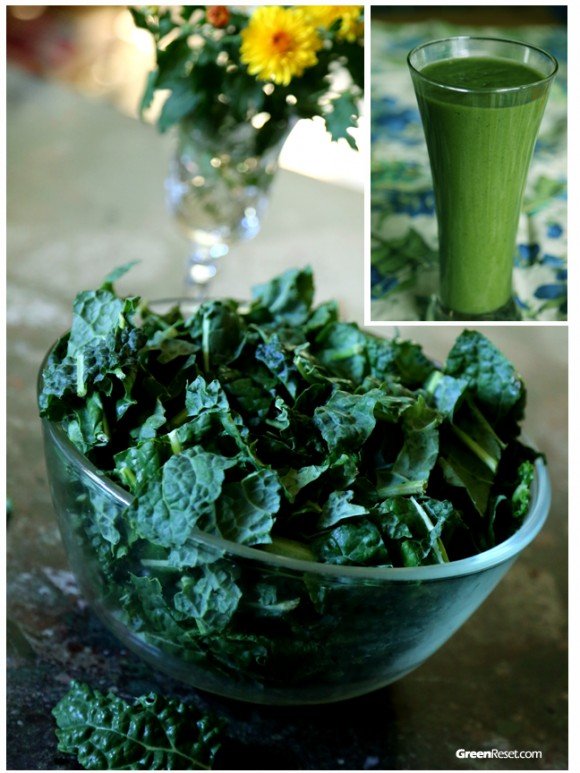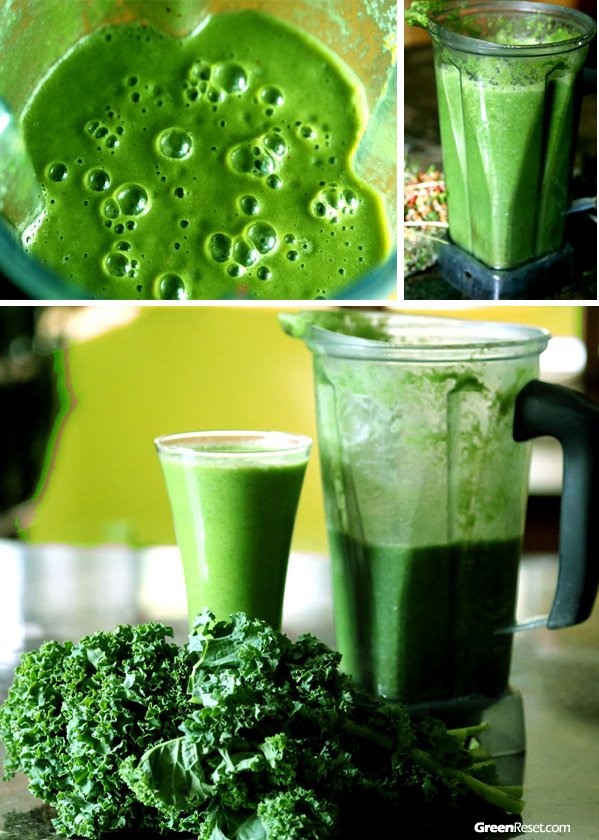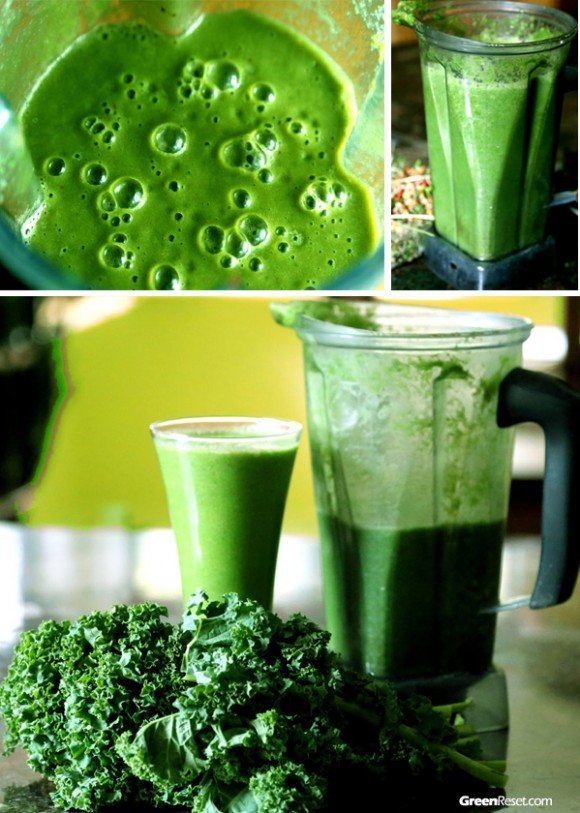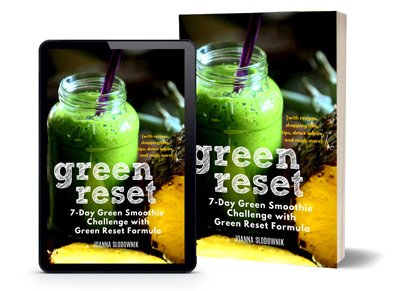Have you already tried a green smoothie recipe with kale?
Kale —and other lelafy greens— are true superfoods. They deliver a bonanza of vitamins, minerals, and phytonutrients. They are loaded with calcium, essential for strong bones and healthy. They provide stress-fighting B vitamins and help our eyes with vitamin A. They even contain small amounts of Omega-3 fats.
But when was the last time you had a bunch of kale?
The fact is kale (and other greens) is often neglected when it comes choosing your ingredients. It’s certainly not most people’s first choice when it comes to preparing salads or vegetable side-dishes.
Especially in winter, when there are fewer in-season vegetable choices — kale and other dark, leafy greens that thrive in cooler weather are a great addition to the menu. Plus, they are great for boosting immunity – so a kale smoothie recipe may be just what the doctor ordered ;-).
When cooked, greens provide more than nine times the recommended amount of vitamin K, which helps our blood clot.
I read once that it was common for our ancient ancestors to eat up to six pounds of leaves per day. You can just picture them wandering from one place to the next, just picking and chewing leaves as all they long they went. That’s a huge amount of greens by anyone’s standards today.
Can you picture yourself devouring a grocery bag full of greens each and every day?
The USDA recommends we eat a minimum of 3 cups of dark leafy greens a week, and very few of us even eat that per week or even month.
How would you feel if you could get those three cups in one large glass?

kale smoothie recipes
Health Benefits of Kale
Kale is really the Queen of Greens. Many health experts consider kale as one of the most nutrient-dense foods on the planet.
Kale belongs to the Brassica family (Brassica oleracea). This family also includes broccoli, bok choy, kohlrabi, cauliflower, Brussels sprouts, cabbage, Chinese cabbage and collard greens. All these greens are well known for their sulfur-containing phytonutrients, which are claimed to help with cancer prevention.
They are also rich sources of vitamin K, vitamin A, vitamin C, and manganese, and is a very good source of dietary fiber, copper, calcium, vitamin B6, and potassium. The health benefits are so numerous, it will be hard to list them all here!
So why not add it to your family’s diet with these easy recipes!

Kale Smoothie Recipes
I use kale A LOT in green smoothies. My son loves kale smoothies too!
I find it really mild tasting (unlike lettuce, Swiss chard, or dandelion greens, for example), so you usually don’t even know it’s there. The fruits really help to mask the strong flavor of the greens.
For most greens, you don’t need a high-speed blender to make a good green smoothie, though the process will be quicker and the result creamier if you do. Kale, however, can be really tough on your blender, so it’s best to use a high power blender, like Vitamix or Blendtec.
Tip: If you don’t own a power blender, try removing the rough stems first, and then just blending the leaves with water for a few minutes first, before adding the rest of the ingredients.
A banana, an avocado, or a small handful of nuts is very helpful to good texture, and a few dried dates will bump up the sweetness in a relatively nutritious way. But beyond that, it’s fun to vary the other ingredients. Try mango, banana, lime, and cilantro, for example—or whatever your palate desires.
Ingredients
- 2 cups sliced banana
- 2 cups freshly squeezed orange or grapefruit juice
- 2 cups tightly packed dinosaur or curly leaf kale
- 1/4 cup lightly packed parsley
- 1/4 cup lightly packed cilantro
- 3 kale leaves
- 1 large ripe banana
- 1 ripe pear
- 1 cup strawberries, fresh or frozen
- 1 cup water
- 1 medium to large ripe banana, peeled
- 2 kale leaves, washed
- 1 celery stalk
- 1 apple
- 1 cup blueberries, fresh or frozen
- 1 cup water
- a splash agave nectar or a packet of stevia (optional) as a sweetener
Instructions
- Blend all ingredients on high speed until creamy. If you like, you may also add a piece of avocado, to add more healthy fats and more creaminess to your smoothie. Add more banana (can be frozen) for a more sweet, thicker smoothie. Enjoy!

6 Delicious Kale Juice Recipes
Kale is also great for juicing.
If you have tried to make kale juice before and it tasted horrible, you may have given up. Plus, some juicers are just not made to juice something like kale.
Do not give up! With the right kale juice recipe, you will love drinking this green!
Just remember that dark greens have strong taste that is not palatable on its own. Always mix green juice them with other sweet tasting veggies and fruits.
You’ll need a lot of kale to make juice. A 1.5 pound bunch of kale yields about 1 cup of vivid green juice using a juicer. You will get more from the kale if you roll the leaves into balls and juice them together with the carrots and apples.
Ingredients
- 5 granny smith apples
- 5 kale leaves
- 1-2 inches of ginger root
- Place all ingredients in a juice extractor or Vita-Mix, juice/blend and enjoy! Serves 4. For babies 12 months and older: dilute by 50% with water and serve!
- Green lemonade contains a big bunch of kale in it along with apples, celery, ginger, and an organic lemon. It tastes amazing.
- 1 bunch of kale
- 2 stalks of celery
- 1 inch piece of ginger
- 2 apples
- 1 lemon with the ends cut off.
- Wash all your goodies thoroughly and pass through the juicer. Ginger adds heat to this tart kale lemonade.
- This variation has some carrots and cucumber added to the mix.
- 4 Medium carrots
- 2 Stalks celery
- 1 Big or 2 small red apples (pitted)
- 4 Kale leaves
- 2 inch length of cucumber (peeled)
- Run ingredients through your juicer. Yield about 2 servings.
- Tip 1: If you feel like having a special treat, you can add some watermelon or cantaloupe chunks if available. This may push the juice quantity up to 3 small servings.
- Tip 2: You can add some ginger for extra bite if you wish. Lemon also goes well with this combination.
More juice recipes:
Minty Kale Juice
Mint adds an interesting touch to this kale juice.
1 1/2 pounds kale
4 peeled parsnips
4 large (or up to 8 small) green apples
1 lime (more or less to taste)
12 ounces mint leaves (about 2 large bunches)
yield: makes about 1 pint of juice, serving two.
Juice and enjoy!
Mixed Greens Juice Recipe
2 limes, zest removed
½ bunch Swiss chard
½ bunch kale
½ bunch dandelion
½ cucumber
2 Granny Smith apples
Juice and enjoy!
Kale Mary
Here is a good one – a Bloody Mary inspired non-alcoholic kale drink.
2 pints grape or cherry tomatoes (they taste better than out-of-season regular tomatoes)
about 1/2 pound kale
4 ribs celery
2 lemons
1 teaspoon prepared horseradish
1 tablespoon soy sauce
Dash hot sauce
Garnish: celery rib
Mix horseradish and soy sauce in a glass. Add tomato juice and stir well until horseradish is well distributed. Add kale juice, celery juice, lemon juice, and hot sauce. Stir well. Serve with celery rib garnish, over ice if desired. Serve immediately. Makes about 1 cup juice (Recipe via Seriouseats).
Enjoy with some crunchy kale chips!
Kale Chips: Low in Calories, Guilt-Free Chips
Here is a recipe for a healthy alternative to potato chips. These crispy little bites of raw kale nutrition are a big hit with young kids (and adults).
Ingredients
- 1 bunch of curly kale, washed well and cut into pieces
- 1 lemon, juiced
- a splash of olive oil
- a splash of agave or maple syrup
- seasoning to taste: salt, pepper, etc.
Instructions
- Preheat oven to 300 degrees.
- Wash 1 bunch of curly kale and cut into chip pieces.
- Arrange in a single layer on a baking sheet and toss with olive oil.
- Add some seasoning to taste: salt, pepper, etc.
- Add the juice of 1 lemon.
- After you’ve massaged your kale with oil and seasoning for a few minutes, take about 1 tablespoon of agave and slowly drizzle it over the kale.
- Bake for about 30 minutes.
- Be amazed!
Notes
Keep in mind that the kale will shrink, so you may try make more than you think you need. If your oven can be set on a low temperature, around 100°F, you can also try to make raw kale chips in the oven. Otherwise you’ll need a dehydrator to make raw kale chips. If using dehydrator, let dehydrate 12 plus hours, until kale is crunchy!
For a much more detailed raw kale crisps recipe, visit this website.

Kale Chips: healthy alternative to potato chips! via http://www.flickr.com/photos/ilovemypit/3425805140/sizes/z/in/photostream/
How To Choose Kale
The deeper the color of the leaves, the higher the nutrient content will be. Make sure that the kale looks fresh and not wilted. Avoid leaves with a lot of yellow or decay. Smaller, tender leaves are best. Pay attention to the stems as well. Make sure that they have a healthy appearance and trim off any thick stems and small blemishes before juicing or cooking.
You can choose either the dark green curly kale or a purple variety. Alternatively you can opt for ornamental kale, which has a less potent flavor. Dinosaur kale is a slightly sweeter choice.
The bitter taste of kale becomes more pronounced the longer it is stored, so it’s best to use it when still fresh. Kale keeps quite well in the fridge, provided that you store it unwashed. As with most of your leafy greens, it is a good idea to wrap the leaves in a paper towel, before placing it in a plastic bag to keep them fresh.
It’s best to buy organic kale grown to avoid toxic, systemic pesticides that are difficult to wash off. Unfortunately, when grown with petrochemical pest controls, kale is number 12 in the Dirty Dozen, tying with collar greens and slightly less than lettuce. Chemical pesticides are toxins, and eating lots of them can be toxic to the central nervous system –including the brain and spinal column, others may disrupt the endocrine function in the body which secrets hormones directly into the blood stream; they may increase the risk of cancers and other diseases.
Make sure you thoroughly wash your greens. Some of the leaves come from right on top of the ground and are usually covered in grit and sand.
Kale can be used in salads and in place of lettuce on sandwiches. However, for these purposes, use only very young, small, tender leaves. Kale is also delicious when steamed with diced onions, and garlic, a little bit of salt and pepper.
For all my blending recipes I use Vitamix. If you don’t already own a VitaMix, I strongly encourage you to check out what this machine is capable of! For more information about VitaMix you can go directly to the VitaMix website. You may also want to read my post about the Best Blender.
I LOVE my VitaMix and highly recommend investing in one if you are ready to make serious changes to your diet. I have had mine for almost 5 years and use it daily!
If you decide to purchase Vitamix – be sure to use Promotional Code 06-004554 to get free shipping.

The Making of Kale Smoothie: Inside of my Vitamix
Questions? Comments? Suggestions?
If you have a favorite recipe, why not submit it here in the comment section of this smoothie recipes blog for others to enjoy too!
I also welcome any comments, questions and suggestions. Thanks!





Thank you so very much for creating this site! I’m learning how to blend better. I’m just starting off & do not have a high end blender…I have the Majic Bullet blender & its helpful so far.
Joanna, thanks these are great recipes.
I am also just learning to juice, your recipes are a good way to learn what ingredients can go together. Very helpful. Thanks!!!
Your site is very informative! I am so happy I came across it! I am relatively new to juicing, I really just started over the past week; by having a breakfast smoothie/juice every day and I have felt a big difference already! I also have just discovered how wonderful kale is, and I love using it in any way I can right now! I have tried Organic Gluten-Free Spicy Kale Chips that are sold at my market, and I would like to make my own Kale Chips soon as well..I also have used it as the main ingredient in my juices over the past week, and I use it as a replacement to lettuce in sandwich wraps that I make..so my question is about the stalks on the Kale..I pull most of the leaves from the stalks when using Kale on my sandwich wraps, but when I put Kale in my Vitamix to make juice I just rinse it off and put the whole thing in the Vitamix…do you recommend doing that or should I pull the leaves from the stem for juicing as well? I also blend the Kale first before adding the rest of my juice ingredients (sometimes I mix some spinach in with it if I have any in the house) because I read somewhere that you should blend the leafy greens alone first before adding the other ingredients when making juices..do you agree with that? I was just curious if it made a real difference or not in the overall result…Thanks again for sharing your great recipes and info..your site is one of the most informative that I have come across during my juicing journey!
**And I LOVE my Vitamix! I haven’t tried any other blenders or juicers besides the Vitamix to compare it to, but I think it is absolutely amazing!!
Hi,
When making smoothies with kale, I do pull the leaves from the tough stems, but I do it quickly by hand and I don’t worry if there’s any stem left – Vitamix can handle that easily! I also don’t worry about blending the greens first – I think this is important if you have a blender that’s not very powerful, just to make sure that these greens are blended well before putting in anything else. Thank you for your comment and keep blending!
Hiya thanks for these great recipes!! I’m new to the smoothie world and love the fact you can have so many flavours. I’m going to try the apple juice one and I will tell you how it goes. Thanks for all your help 👍🏻
Oh forgot to ask do you only mix them with water or can you use almond milk or natural yoghurt? Xxx